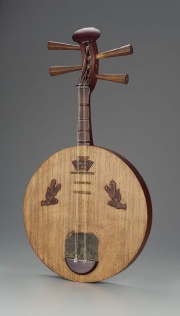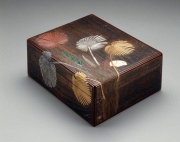Difference between revisions of "Paulownia wood"
Jump to navigation
Jump to search
m (Text replace - "== Authority ==" to "== Sources Checked for Data in Record ==") |
|||
| (One intermediate revision by the same user not shown) | |||
| Line 1: | Line 1: | ||
| − | [[File:17.2153-SC24684.jpg|thumb|]] | + | [[File:17.2153-SC24684.jpg|thumb|Chinese lute<br>MFA# 17.2153]] |
== Description == | == Description == | ||
| − | + | [[File:08.170-E5155CR-d1.jpg|thumb|Writing paper box<br>MFA# 08.170]] | |
A lightweight wood obtained from several species of ''Paulownia'' trees native to Asia. Paulownia trees produce a soft, coarse-grain wood that is similar to balsa. Even though the wood is lightweight, it is strong and warp resistant. Paulownia wood is used as a lightweight crating lumber and for floats. Wood from the ''Paulownia tomentosa'' tree, native to Japan, is used for scroll boxes. | A lightweight wood obtained from several species of ''Paulownia'' trees native to Asia. Paulownia trees produce a soft, coarse-grain wood that is similar to balsa. Even though the wood is lightweight, it is strong and warp resistant. Paulownia wood is used as a lightweight crating lumber and for floats. Wood from the ''Paulownia tomentosa'' tree, native to Japan, is used for scroll boxes. | ||
| Line 8: | Line 8: | ||
''Paulownia''; kiri wood (Jap.); paulownia (Fr.); empress tree; princess tree; palownia (sp) | ''Paulownia''; kiri wood (Jap.); paulownia (Fr.); empress tree; princess tree; palownia (sp) | ||
| − | + | ==Physical and Chemical Properties== | |
| − | + | ||
| − | + | * Trees grow 30-65 ft (10-20m) tall with 2-4ft (0.6-1.2m) trunk diameter | |
| − | + | * Heartwood is a pale grayish brown with whitish sapwood | |
| − | + | * Grain is usually straight with a coarse uneven texture | |
| − | + | * Resistant to decay and weathering but not to insects | |
| + | * Density = 14-19 ppcf | ||
| + | |||
| + | ==Working Properties== | ||
| + | * Easy to work | ||
| + | * High silica in some trees can have a strong blunting effect on cutting edges | ||
| + | * Takes a wide variety of glues, stains, and finishes well | ||
| + | |||
| + | ==Resources and Citations== | ||
| − | + | * The Wood Database: [https://www.wood-database.com/paulownia/ Paulownia] | |
* G.S.Brady, ''Materials Handbook'', McGraw-Hill Book Co., New York, 1971 Comment: p. 83 | * G.S.Brady, ''Materials Handbook'', McGraw-Hill Book Co., New York, 1971 Comment: p. 83 | ||
| Line 23: | Line 31: | ||
* ''The American Heritage Dictionary'' or ''Encarta'', via Microsoft Bookshelf 98, Microsoft Corp., 1998 | * ''The American Heritage Dictionary'' or ''Encarta'', via Microsoft Bookshelf 98, Microsoft Corp., 1998 | ||
| − | * | + | * Museum of Japanese Traditional Art Crafts at http://www.nihon-kogeikai.com/ (Jap. term) |
[[Category:Materials database]] | [[Category:Materials database]] | ||
Latest revision as of 11:53, 27 September 2022
Description
A lightweight wood obtained from several species of Paulownia trees native to Asia. Paulownia trees produce a soft, coarse-grain wood that is similar to balsa. Even though the wood is lightweight, it is strong and warp resistant. Paulownia wood is used as a lightweight crating lumber and for floats. Wood from the Paulownia tomentosa tree, native to Japan, is used for scroll boxes.
Synonyms and Related Terms
Paulownia; kiri wood (Jap.); paulownia (Fr.); empress tree; princess tree; palownia (sp)
Physical and Chemical Properties
- Trees grow 30-65 ft (10-20m) tall with 2-4ft (0.6-1.2m) trunk diameter
- Heartwood is a pale grayish brown with whitish sapwood
- Grain is usually straight with a coarse uneven texture
- Resistant to decay and weathering but not to insects
- Density = 14-19 ppcf
Working Properties
- Easy to work
- High silica in some trees can have a strong blunting effect on cutting edges
- Takes a wide variety of glues, stains, and finishes well
Resources and Citations
- The Wood Database: Paulownia
- G.S.Brady, Materials Handbook, McGraw-Hill Book Co., New York, 1971 Comment: p. 83
- Marjorie Shelley, The Care and Handling of Art Objects, The Metropolitan Museum, New York, 1987
- The American Heritage Dictionary or Encarta, via Microsoft Bookshelf 98, Microsoft Corp., 1998
- Museum of Japanese Traditional Art Crafts at http://www.nihon-kogeikai.com/ (Jap. term)

